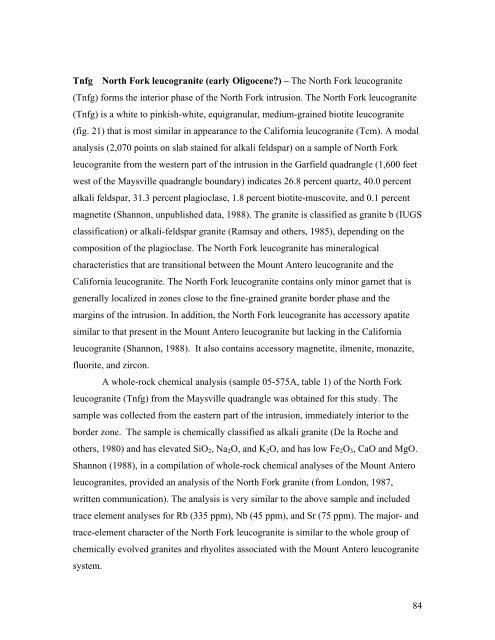Geologic Map of the Maysville Quadrangle, Chaffee County, Colorado
Geologic Map of the Maysville Quadrangle, Chaffee County, Colorado
Geologic Map of the Maysville Quadrangle, Chaffee County, Colorado
Create successful ePaper yourself
Turn your PDF publications into a flip-book with our unique Google optimized e-Paper software.
Tnfg North Fork leucogranite (early Oligocene) – The North Fork leucogranite<br />
(Tnfg) forms <strong>the</strong> interior phase <strong>of</strong> <strong>the</strong> North Fork intrusion. The North Fork leucogranite<br />
(Tnfg) is a white to pinkish-white, equigranular, medium-grained biotite leucogranite<br />
(fig. 21) that is most similar in appearance to <strong>the</strong> California leucogranite (Tcm). A modal<br />
analysis (2,070 points on slab stained for alkali feldspar) on a sample <strong>of</strong> North Fork<br />
leucogranite from <strong>the</strong> western part <strong>of</strong> <strong>the</strong> intrusion in <strong>the</strong> Garfield quadrangle (1,600 feet<br />
west <strong>of</strong> <strong>the</strong> <strong>Maysville</strong> quadrangle boundary) indicates 26.8 percent quartz, 40.0 percent<br />
alkali feldspar, 31.3 percent plagioclase, 1.8 percent biotite-muscovite, and 0.1 percent<br />
magnetite (Shannon, unpublished data, 1988). The granite is classified as granite b (IUGS<br />
classification) or alkali-feldspar granite (Ramsay and o<strong>the</strong>rs, 1985), depending on <strong>the</strong><br />
composition <strong>of</strong> <strong>the</strong> plagioclase. The North Fork leucogranite has mineralogical<br />
characteristics that are transitional between <strong>the</strong> Mount Antero leucogranite and <strong>the</strong><br />
California leucogranite. The North Fork leucogranite contains only minor garnet that is<br />
generally localized in zones close to <strong>the</strong> fine-grained granite border phase and <strong>the</strong><br />
margins <strong>of</strong> <strong>the</strong> intrusion. In addition, <strong>the</strong> North Fork leucogranite has accessory apatite<br />
similar to that present in <strong>the</strong> Mount Antero leucogranite but lacking in <strong>the</strong> California<br />
leucogranite (Shannon, 1988). It also contains accessory magnetite, ilmenite, monazite,<br />
fluorite, and zircon.<br />
A whole-rock chemical analysis (sample 05-575A, table 1) <strong>of</strong> <strong>the</strong> North Fork<br />
leucogranite (Tnfg) from <strong>the</strong> <strong>Maysville</strong> quadrangle was obtained for this study. The<br />
sample was collected from <strong>the</strong> eastern part <strong>of</strong> <strong>the</strong> intrusion, immediately interior to <strong>the</strong><br />
border zone. The sample is chemically classified as alkali granite (De la Roche and<br />
o<strong>the</strong>rs, 1980) and has elevated SiO 2 , Na 2 O, and K 2 O, and has low Fe 2 O 3 , CaO and MgO.<br />
Shannon (1988), in a compilation <strong>of</strong> whole-rock chemical analyses <strong>of</strong> <strong>the</strong> Mount Antero<br />
leucogranites, provided an analysis <strong>of</strong> <strong>the</strong> North Fork granite (from London, 1987,<br />
written communication). The analysis is very similar to <strong>the</strong> above sample and included<br />
trace element analyses for Rb (335 ppm), Nb (45 ppm), and Sr (75 ppm). The major- and<br />
trace-element character <strong>of</strong> <strong>the</strong> North Fork leucogranite is similar to <strong>the</strong> whole group <strong>of</strong><br />
chemically evolved granites and rhyolites associated with <strong>the</strong> Mount Antero leucogranite<br />
system.<br />
84




